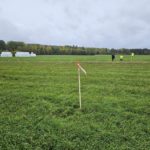Arctic Sustainability Group continues its work toward building a large-scale land-based fish farm in Storfors, Sweden. This first facility, which will stand model for customers wishing to buy our technology, is designed for growing Arctic char (sv. Röding, sp. Salvelinus alpinus).
In our interactions with stakeholders (i.e. customers, citizens, investors, authorities etc.) we have gotten many questions from Sweden and abroad about the size of the Swedish aquaculture industry. Through this news-blog we will try to share some information that we believe is valuable for anyone interested in Swedish aquaculture.
Today, there are 369 registered fish farms in Sweden of which a slight majority are land-based (53.1%), the rest being pen-based in fresh, saline or brackish waters (46.9%). Arctic Char is today cultivated in 46 fish farms in Sweden, a majority of which are land-based (63%). Many of these also cultivate more than one species: common examples include Trout, Rainbow Trout and Grayling which are often seen cultivated in addition to Arctic Char.

Figure 1. Number of fish farms in Sweden. Data publicly accessible from the Swedish Board of Agriculture.
Land-based fish farms may also differ in their purpose. As seen in the diagram below, Swedish land-based fish farms that cultivate Arctic Char have different purposes involving:
producing fish for further production in pen-based aquaculture (sv. sättfisk)
producing fry and fingerlings for further growth elsewhere
to conduct broodstock operations
to release fish into the wild

Figure 2. Purposes of land-based fish farms that cultivate Arctic Char. Data publicly accessible from the Swedish Board of Agriculture.
Broodstock operations are essential to ensure the production of fry and fingerlings, which then are often sold between fish farms to keep the genetic diversity of the farmed species. Releasing fish into the wild is often done to aid sport fishing activities or as compensation for hydroelectric dams. Fish are also produced for further growth in pen-based aquaculture operations to minimize risk as juvenile fish are more susceptible to diseases.
The Swedish aquaculture industry is larger than many people realize and fish are produced for many different purposes. Arctic Sustainability Group is aiming to further develop the quality of both present and future land-based fish farms with its technology and system designs, this will enable further expansion of the industry and ensure the food supply for generations to come. Through the company’s technology and delivery organisation we make it easier to invest in, build, start and operate a fish farm in Sweden and abroad. Our purpose is to deliver the best and most cost effective solutions to new and establised fish-farmers everywhere.
Disclaimer: All data is sourced (2023-10-08) from the Aquaculture Establishment Register of the Swedish Board of Agriculture. Arctic Sustainability Group can’t take responsibility for any deviations in the database but is aware that closures and new projects will affect the number of fish farms in the database.




